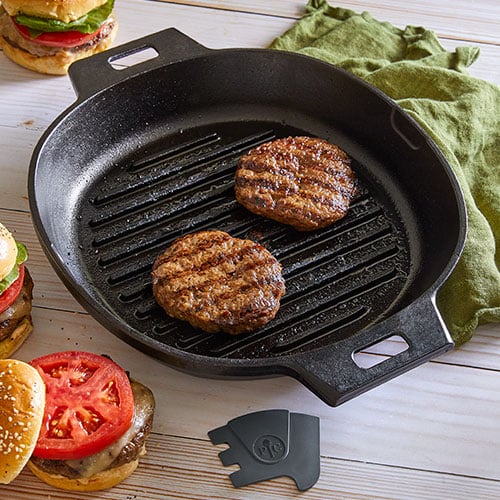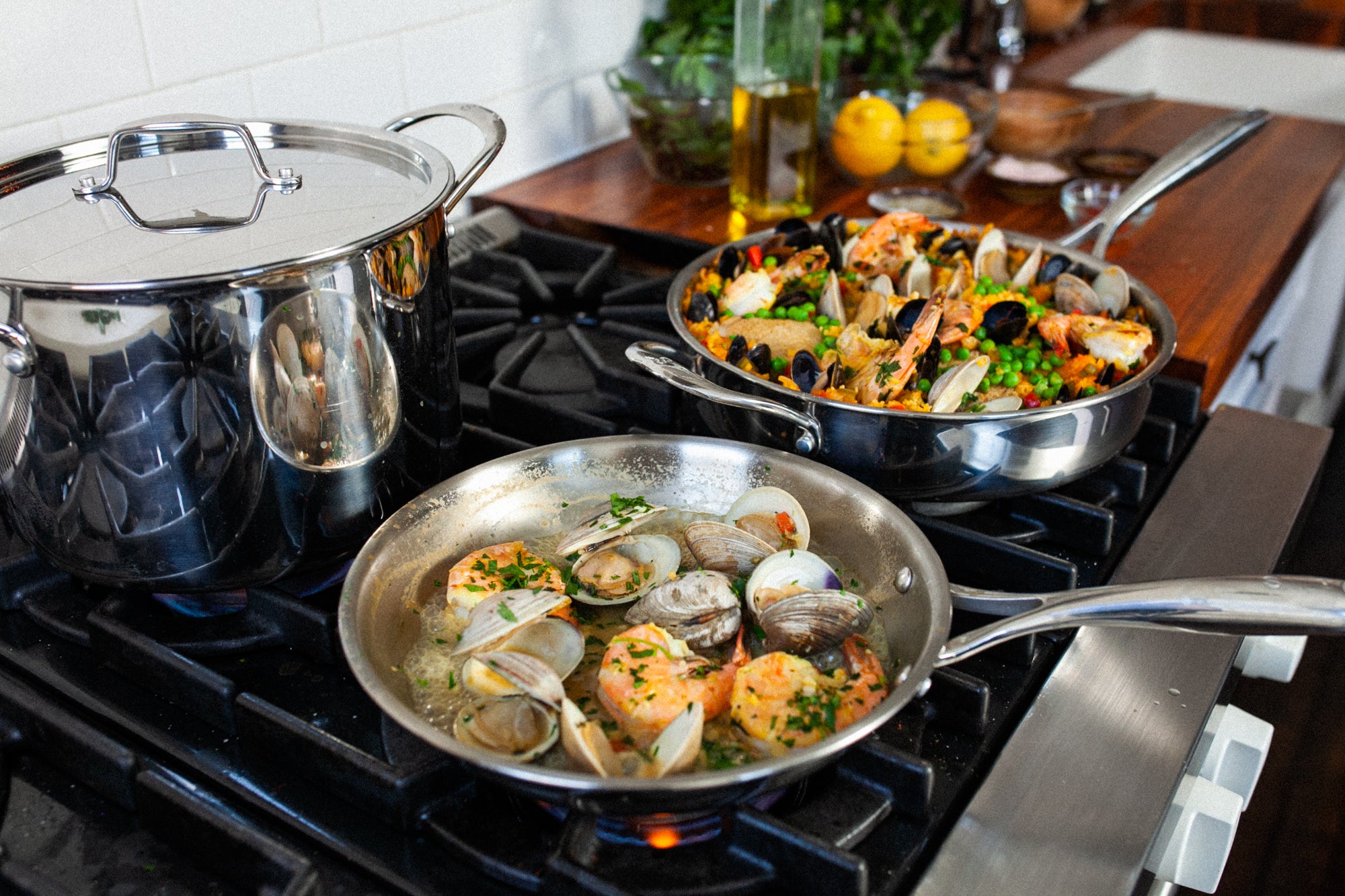Your Full Skillet Guide: From Spices to Searing with Excellence
Wiki Article
Master the Art of Food Preparation With a Frying Pan: a Newbie's Overview
Master the Art of Food Preparation With a Frying Pan: a Beginner's Overview is an extensive source for individuals excited to improve their cooking skills making use of a flexible kitchen area tool - the skillet. From picking the ideal skillet to understanding vital strategies and warm control, this overview covers all the principles essential to end up being a skilled frying pan cook.Picking the Right Frying Pan
Selecting the best frying pan is crucial for mastering the art of cooking with this versatile cooking area tool. With so many alternatives readily available out there, it can be overwhelming to make the best selection. However, recognizing the vital variables to think about can streamline the decision-making process.Most importantly, it is essential to think about the product of the frying pan. Skillets are commonly made from cast iron, stainless-steel, or non-stick covered products. Each material has its very own advantages and disadvantages. Cast iron skillets are known for their outstanding warmth retention and toughness, while stainless-steel frying pans supply also warmth circulation and are simple to preserve. Non-stick skillets are fantastic for low-fat food preparation and simple clean-up.
It is recommended to select a skillet that matches the dimension of your stovetop heater. A frying pan that is too small might result in congestion, while a frying pan that is as well huge can lead to unequal food preparation.
Lastly, handle layout and heat resistance ought to likewise be thought about. A skillet with a long and comfy take care of enables simple ability to move and reduces the threat of burns. Furthermore, the deal with need to be heat-resistant to guarantee secure handling throughout cooking.
Necessary Frying Pan Methods
To truly grasp the art of cooking with a frying pan, it is necessary to discover an array of strategies that will certainly raise your cooking abilities to new heights. While the skillet is a indispensable and versatile device in the kitchen area, understanding and understanding these techniques will certainly allow you to produce a variety of scrumptious meals effortlessly.One necessary technique is sautéing, which entails cooking food rapidly in a tiny quantity of hot oil or fat. This technique is excellent for cooking veggies, meat, or seafood, as it assists to keep their natural tastes and appearances.
An additional vital strategy is hot, which involves food preparation food over high warm to produce a flavorful and browned exterior. This is often done with meats, such as steak or poultry, to create a caramelized crust while maintaining the interior damp and tender.
Deglazing is also an useful technique that involves including liquid, such as brew or red wine, to the skillet after cooking meat - skillet guide. This assists to develop a delicious sauce by loosening and including the browned bits adhered to the bottom of the frying pan
Last but not least, stir-frying is a popular strategy that includes rapidly cooking tiny items of food over high warmth while constantly stirring. This approach is commonly utilized in Eastern food and allows for a quick and delicious meal.

Understanding Warm Control
When cooking with a frying pan,Mastering warmth control is crucial for achieving ideal outcomes. The capability to adjust and regulate the temperature level allows you to cook numerous active ingredients to excellence. Comprehending heat control not just prevents your food from shedding or undercooking, but it additionally improves tastes and textures.To begin, it is necessary to pre-heat your frying pan effectively. Reduced warm is optimal for delicate foods that require mild food preparation, such as fish or eggs.
Adjusting the warm too often can influence the cooking process. If you see your food cooking also rapidly, lower the warm slightly.
Lastly, bear in mind the warmth retention useful link homes of your frying pan. Cast iron skillets, for example, preserve heat well and need lower warm settings compared to stainless steel or non-stick pans. By understanding your frying pan's warm conductivity, you can much better regulate the cooking procedure and accomplish regular results.
Taking Care Of Your Skillet
Correct upkeep is essential to preserving the durability and efficiency of your skillet. Caring for your frying pan entails a couple of straightforward yet important actions that will certainly ensure it continues to be from this source in superb problem for many years ahead.
Second of all, it is suggested to season your frying pan frequently. Spices includes applying a thin layer of oil to the skillet's surface area and home heating it up until it polymerizes, creating a natural non-stick covering. This process boosts the frying pan's performance and protects against food from sticking.
In addition, keeping your frying pan properly is necessary. To prevent scratching or damaging the surface, position a paper towel or fabric in between each skillet if you pile them. It is likewise a good idea to save your skillet in a completely dry location to stop wetness and rust formation.
Lastly, bear in mind to periodically inspect your skillet for any kind of indicators of wear or damage - skillet guide. If you notice any type of problems, resolve them quickly to stop additional wear and tear.
Delicious Frying Pan Recipes
For those looking to increase their cooking arsenal, the skillet provides a selection of scrumptious recipe alternatives. The convenience of this kitchen area device enables a variety of food preparation strategies, from burning and browning to sautéing and simmering. Whether you choose meat, seafood, veggies, or grains, there are plenty of frying pan dishes that will please even one of the most critical palate.One classic frying pan recipe is the seared steak. By preheating the skillet and including a touch of oil, you can accomplish a flawlessly caramelized crust outside while maintaining the meat tender and juicy on the inside. Couple it with a side of sautéed veggies or a velvety mushroom sauce for a hearty and total dish.
If you're in the state of mind for fish and shellfish, a skillet dish like lemon garlic shrimp is both delicious and quick. With just a couple of simple components like fresh shrimp, Look At This diced garlic, lemon juice, and butter, you can produce a delicious recipe that can be taken pleasure in on its own or offered over pasta or rice.
For vegetarians, a frying pan recipe like ratatouille is a fantastic option. This conventional French recipe features a medley of vivid vegetables such as eggplant, zucchini, bell peppers, and tomatoes, prepared with each other with seasonings and herbs to produce an unified mix of flavors.
Final Thought
In conclusion, understanding the art of food preparation with a frying pan needs selecting the best frying pan, finding out essential methods, grasping warmth control, and caring for the skillet properly. By following these steps, novices can end up being knowledgeable in operation a skillet for different delicious recipes.Master the Art of Food Preparation With a Skillet: a Beginner's Overview is a detailed resource for people anxious to boost their culinary skills making use of a functional kitchen area tool - the frying pan. From choosing the right skillet to grasping vital strategies and heat control, this guide covers all the principles required to come to be an experienced frying pan cook. Furthermore, it offers valuable insights on proper skillet upkeep and supplies a collection of tasty recipes that showcase the skillet's capacity. Cast iron skillets are recognized for their excellent heat retention and longevity, while stainless steel frying pans supply even warmth circulation and are easy to maintain. A skillet that is also tiny may result in overcrowding, while a skillet that is too large can lead to unequal food preparation.
Report this wiki page